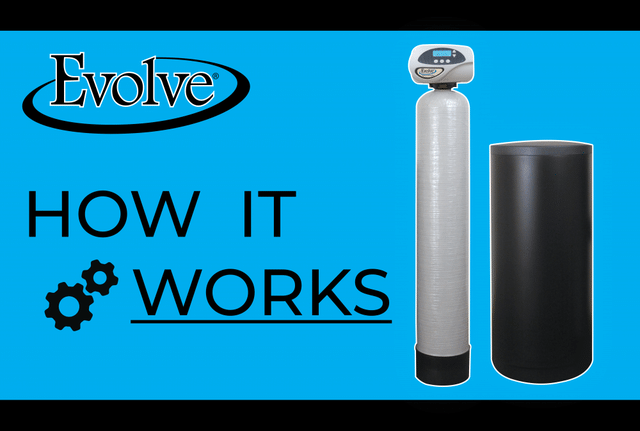
If you’re doing research in preparation to purchase a water softener or if you’ve had one installed for a few years now, you’re probably aware of why you need one in your home. Removing hardness minerals in your home’s water supply is a no brainer if you want to keep everything running smoothly and efficiently.
But, you may be curious about the whats and the hows behind the water softening process in your home. How does adding salt to water remove hardness? What exactly is inside those tanks? What is my water softener doing when it regenerates at night?
We don’t often ask those questions about the appliances in our homes. We just expect them to do their job and work as they’re meant to. The calculated science behind how your water softener treats your water is worth understanding, though, and may give you a better appreciation towards the hard work that it does behind the scenes.
Softener Components
Your Evolve water softener or conditioner is made up of two main components; the media tank and the brine tank. The media tank contains an ion-exchange softening media inside, either resin beads or zeolite. On the top of the tank is a controller which contains the electronics to allow an installer to program-specific settings unique to your home’s water treatment needs. Next to the media tank is the brine tank, a shorter tank which contains softener salt used to regenerate the system once it has absorbed its capacity of hardness minerals.
The two tanks are connected by a brine line which feeds water between the two during regeneration.
What is Ion Exchange?
The resin media inside the media tank is made up of small, negatively charged beads with microscopic dimples on them (picture a golf ball). Alternatively, a conditioner is equipped with Crystal-Right™, Evolve’s exclusive, synthetic zeolite media which works under the same principle as resin. When the media is fresh and able to remove hard water minerals, these dimples contain positively charged sodium ions which are attracted to the negatively charged resin beads like a magnet.
Hard water contains elements such as calcium, magnesium, and iron. Like sodium ions, hardness minerals are all positively charged. The only difference is that they have a much stronger charge and attracting force than their sodium counterparts.
When hard water runs through the media tank, the stronger charged hardness ions are also attracted to the resin beads like a magnet and force off the weaker charged sodium ions. The hardness minerals then continue to stick to the media while the sodium ions are washed out of the media tank. Since the hardness minerals are unable to make it through the tank without being captured by the media, the water supplied from the media tank has no calcium and is considered soft. This soft water exits out of the tank and is dispersed throughout the home.
Regeneration
When the media beads or zeolite crystals become too full of captured hardness ions and will no longer be able to provide treated water, the system will regenerate. Typically, this is set to occur in the middle of the night when your home is not using any water.
A typical softener regeneration has four main steps, all of them taking place while you’re sleeping!
1.Brine Tank Fill: The media tank will supply softened water to the brine tank and fill it up partially. When the water comes in contact with the salt (a.k.a. sodium chloride) inside, it will form a salt water solution called brine. This water will sit for a few hours to fully dissolve some of the salt in the tank to make a concentrated brine solution.
2.Backwash: Raw water will enter the media tank through a tube that runs through the middle of the tank. This water will then be forced up from the bottom of the tank to the top, which stirs and agitates the media and flushes out any debris to the drain.
3.Brine Draw: Once the water has had enough time to dissolve the salt in the brine tank, the salt water is drawn into the media tank. The positive sodium ions from the sodium chloride compound in the salt solution break apart to take back their place on the negatively charged media bead by forcing the hardness minerals out to the drain.
4.Rinse: The media tank is rinsed to force out any extra salt and send it down the drain.
Following the rinse, the unit then returns to its service position and is ready to soften water again. The media beads or crystals are once again charged with the weaker sodium ions, ready to be exchanged for any hardness minerals that pass through.
Your Evolve water conditioner or softener will continue to operate and regulate itself as needed if it’s installed and programmed correctly and if salt is added regularly to its brine tank. Everything, including the ion exchange and regeneration process, works behind the scenes ensuring that your home has continually soft water.
The science behind softening water is a precise one and there is no one size fits all solution to problem water. In order to get your water softener to work to the best of its ability, it’s necessary to conduct a water test to understand the makeup of your home’s water first. That’s where your local water experts come into play. Your local Evolve dealer will test your home’s water, examine the results, and prescribe a water softener specifically for your home. Call us today!
